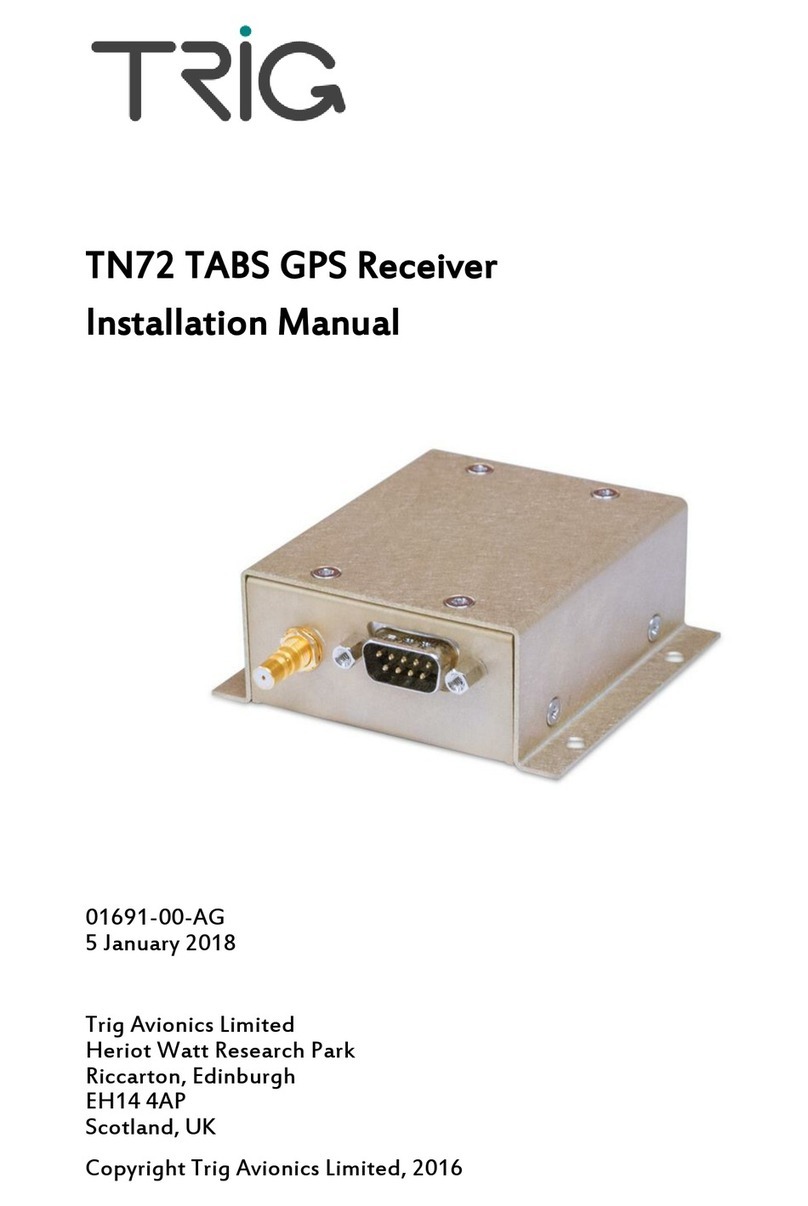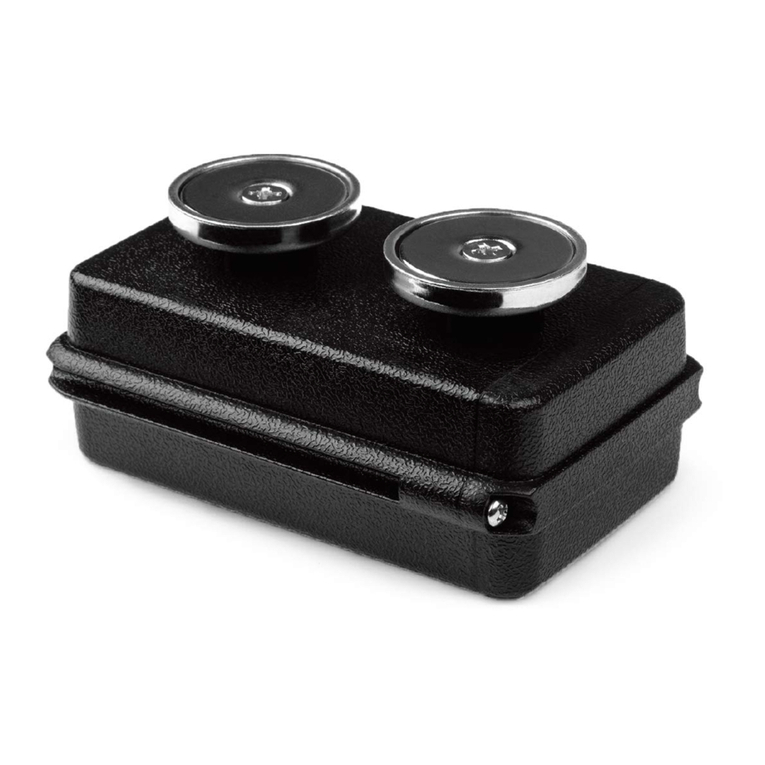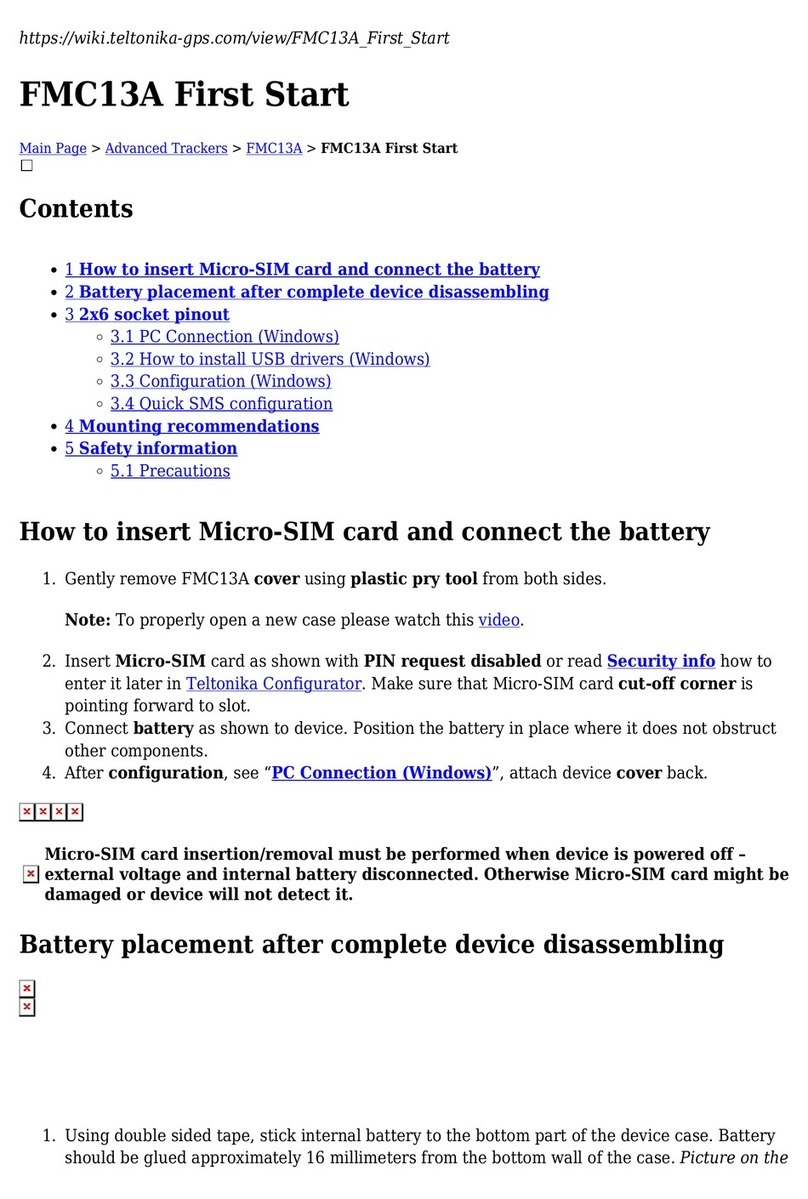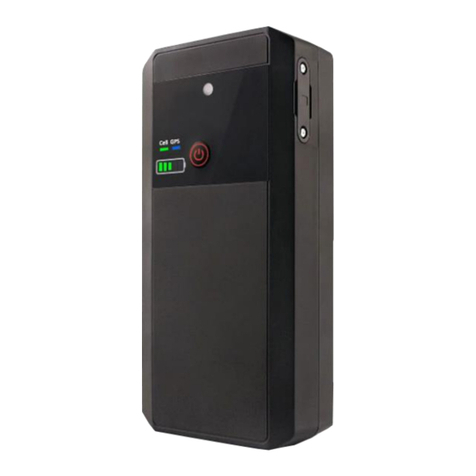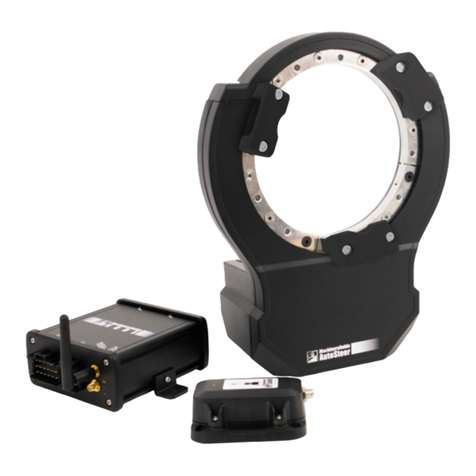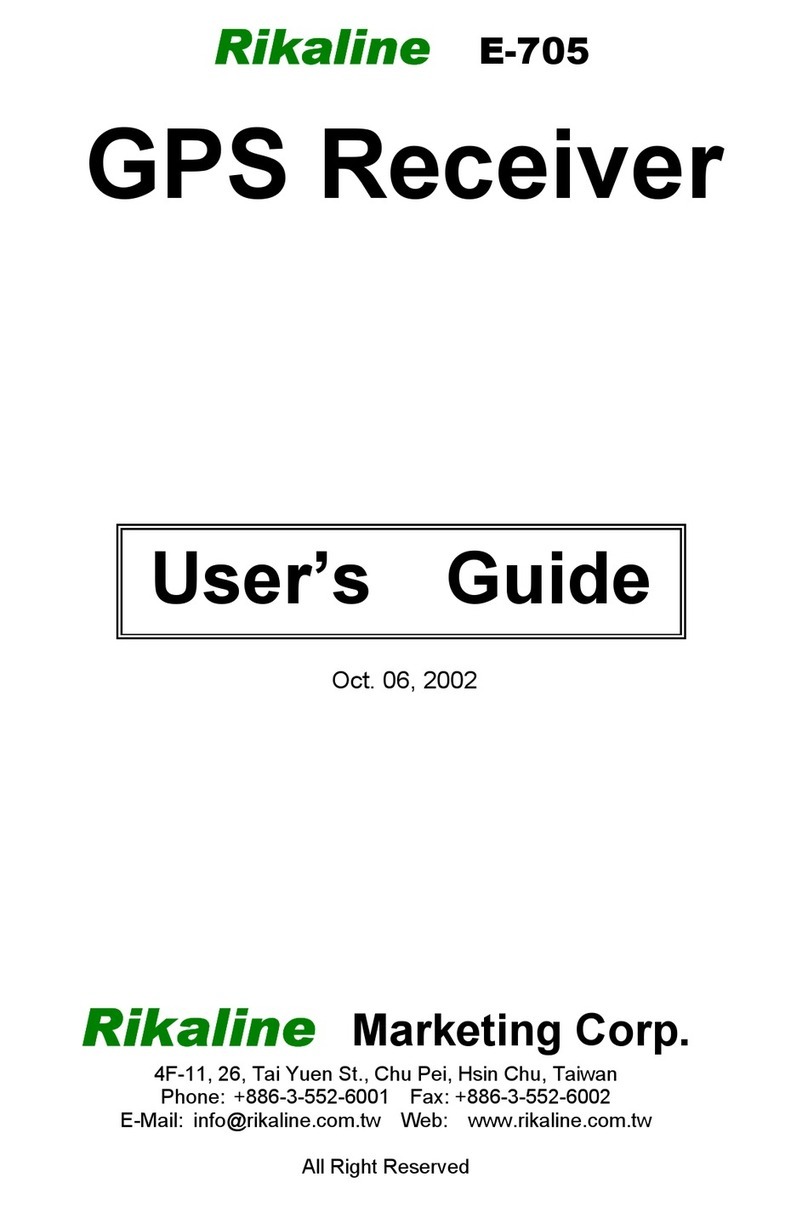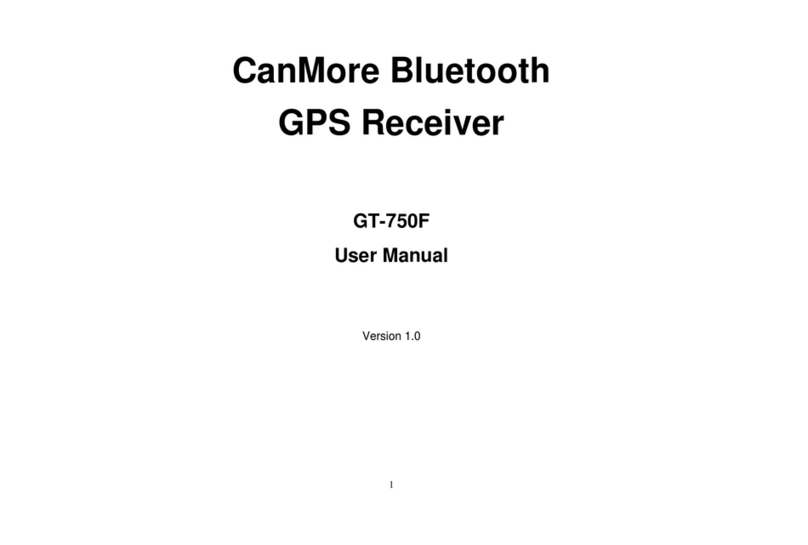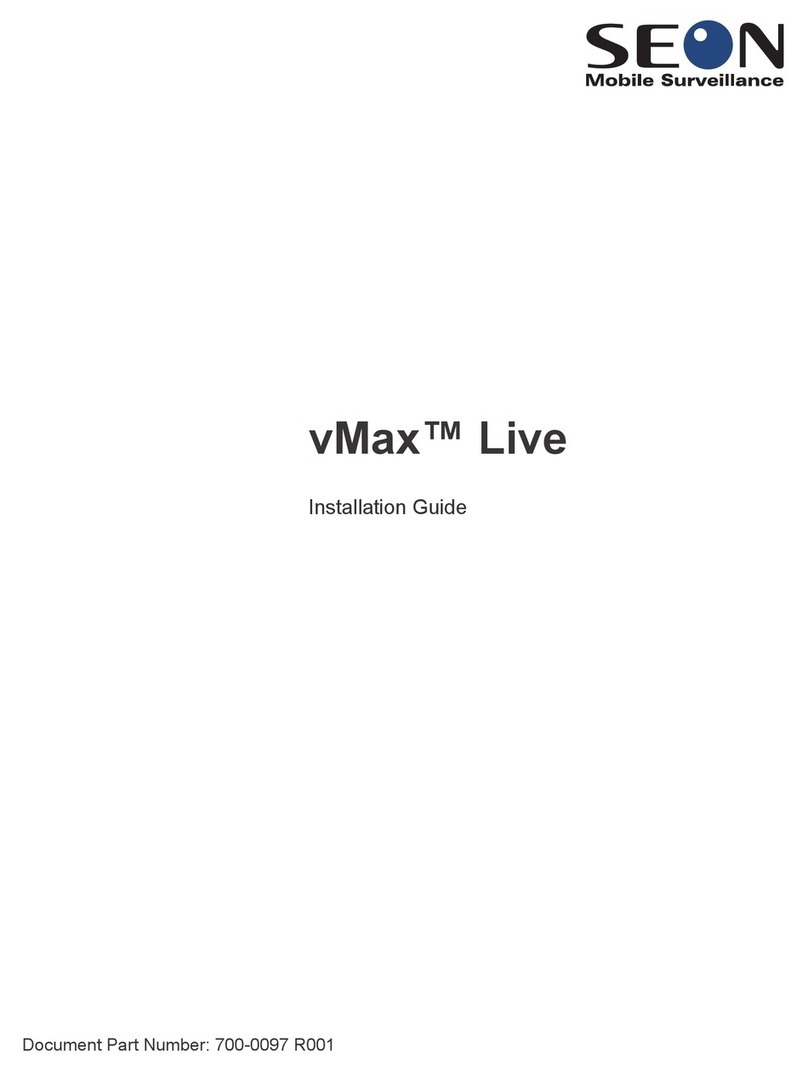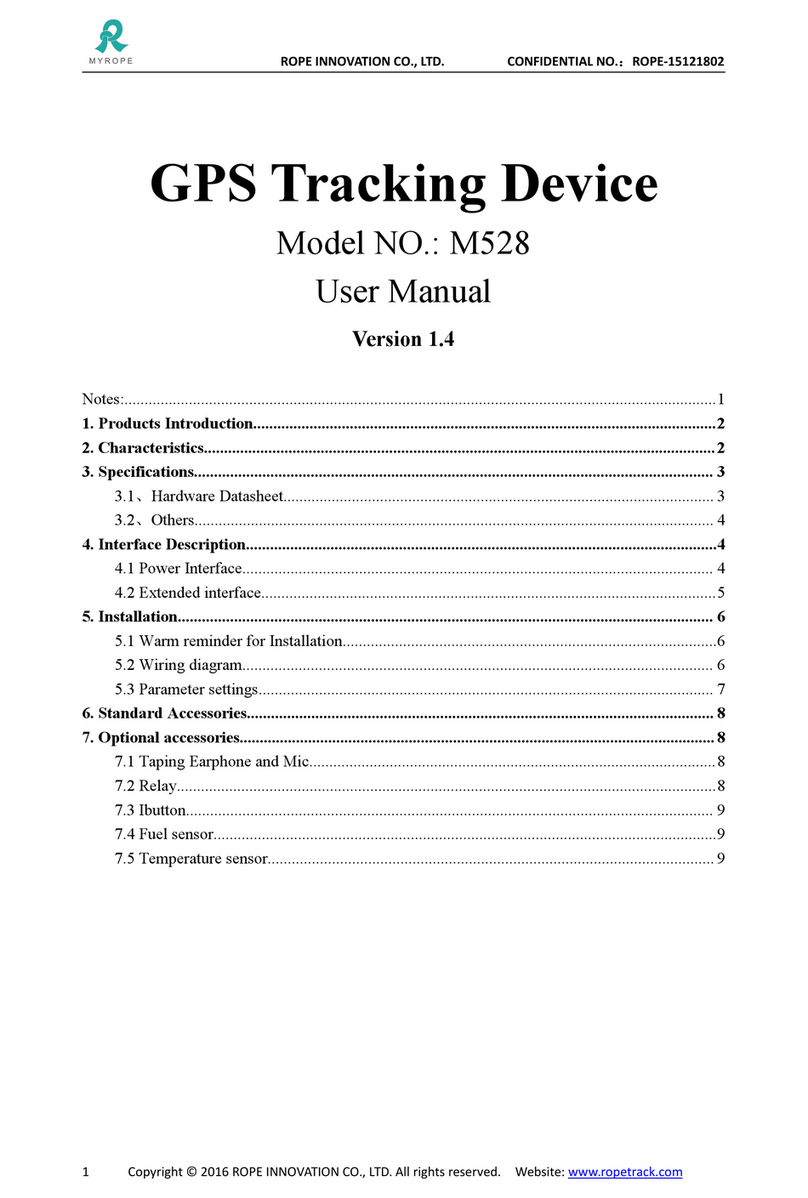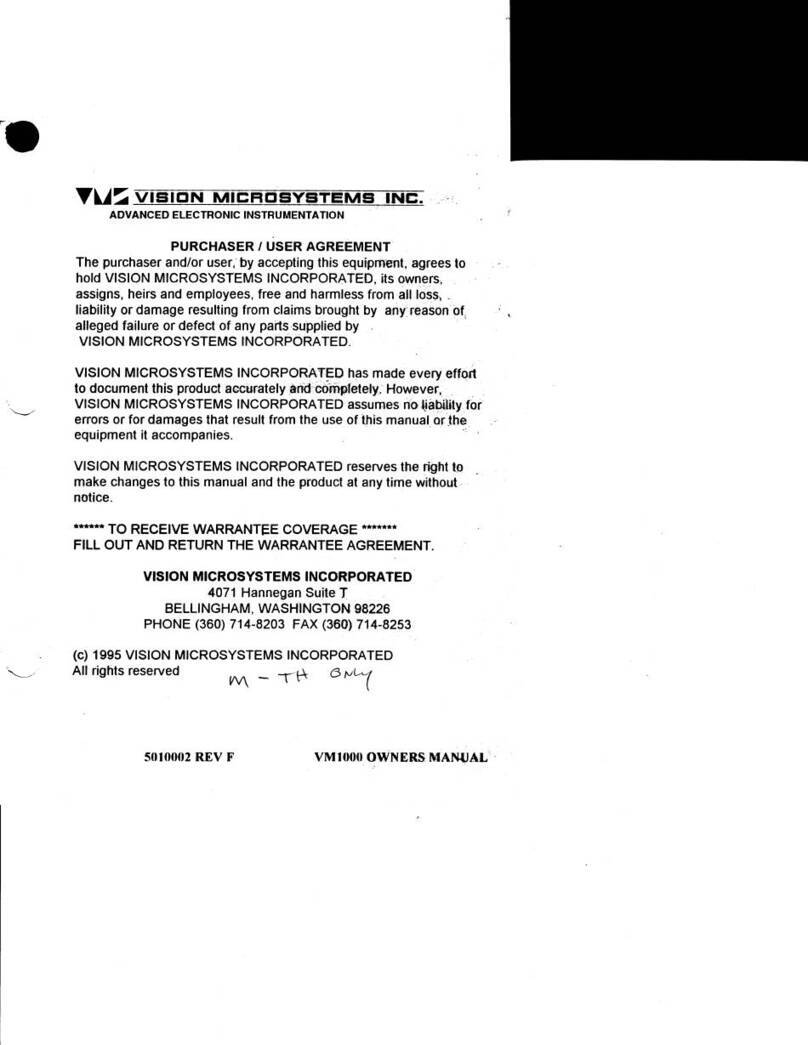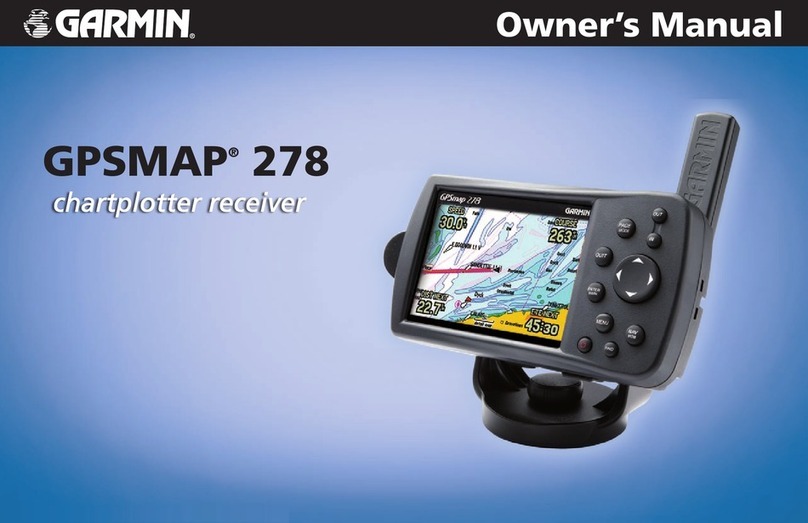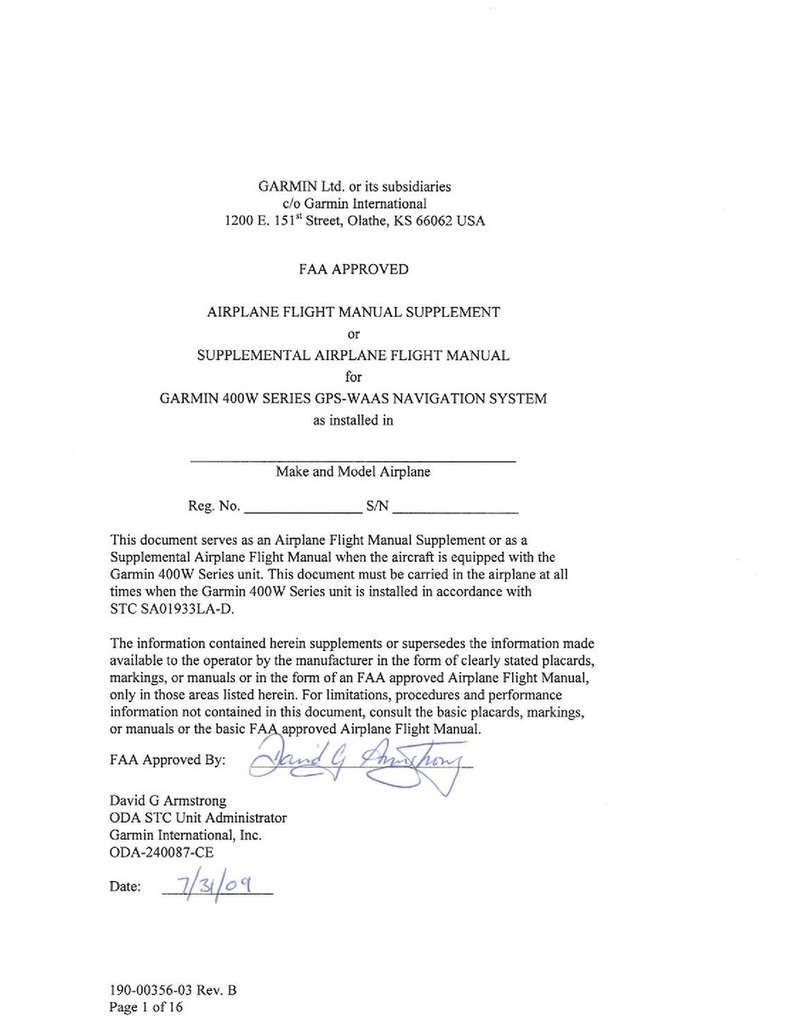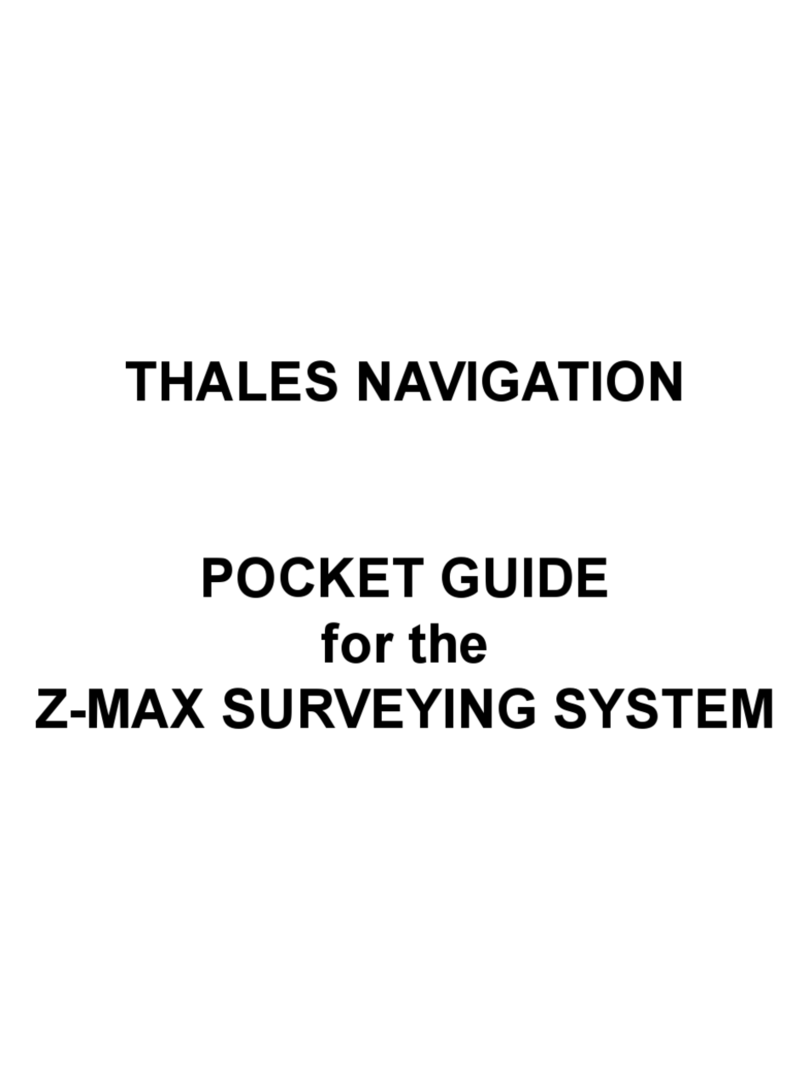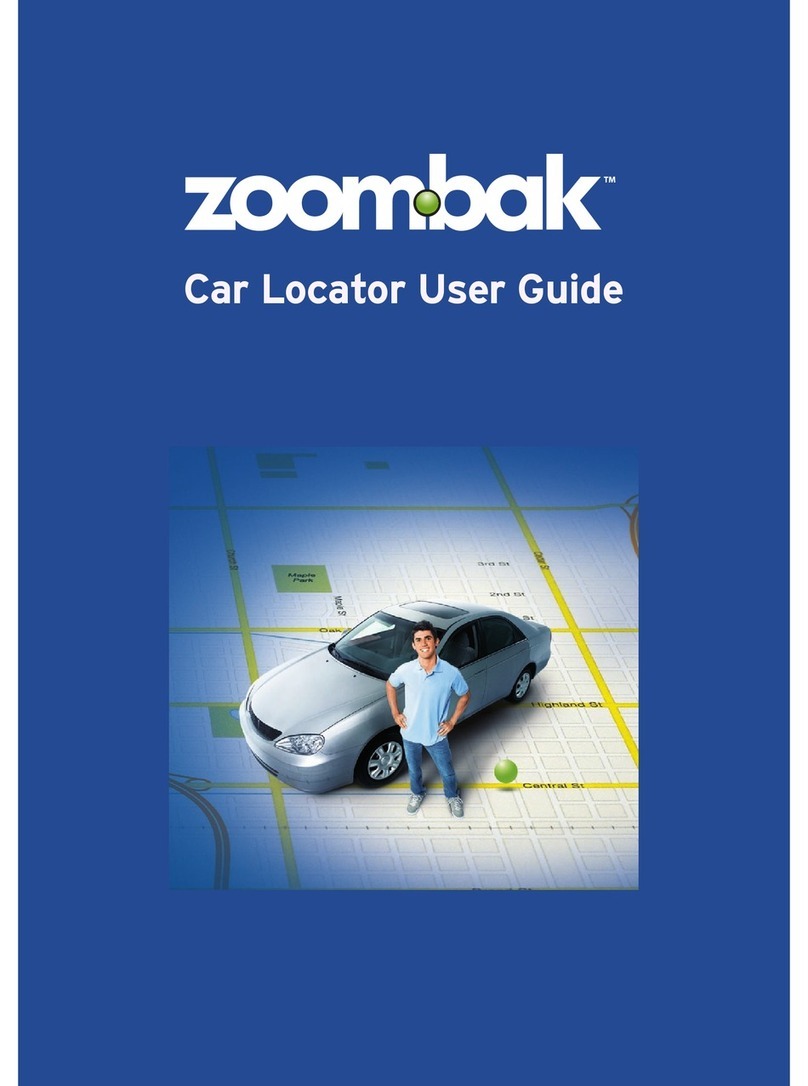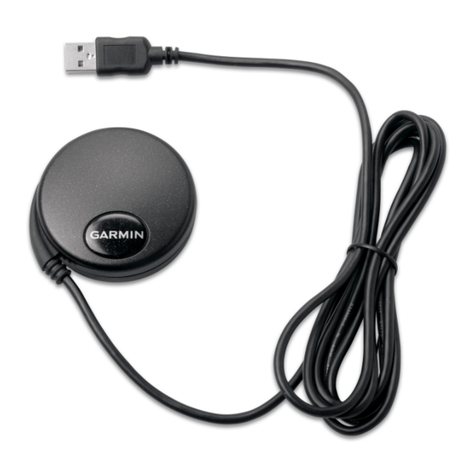trig TT31 User manual

TT31 Mode S Transponder
Installation Manual
00455-00-AQ
8 May 2017
Trig Avionics Limited
Heriot Watt Research Park
Riccarton, Currie
EH14 4AP
Scotland, UK
Copyright Trig Avionics Limited 2006 - 2017

This page intentionally left blank

TT31 Transponder Installation Manual 8 May 2017
00455-00 Issue AQ
______________________
Trig Avionics Limited i
CONTENTS
1. PREFACE.......................................................................................................................................1
1.1 PURPOSE....................................................................................................................................1
1.2 SCOPE........................................................................................................................................1
1.3 CHANGES FROM PREVIOUS ISSUE..............................................................................................1
1.4 DOCUMENT CROSS-REFERENCES ..............................................................................................1
2. INTRODUCTION ..........................................................................................................................2
2.1 TT31 DESCRIPTION ...................................................................................................................2
2.2 INTERFACES...............................................................................................................................2
3. TECHNICAL SPECIFICATIONS...............................................................................................4
3.1 REGULATORY............................................................................................................................4
3.1.1 Approved Deviations ........................................................................................................4
3.2 PHYSICAL SPECIFICATIONS (IN TRAY).......................................................................................4
3.3 INSTALLATION APPROVAL.........................................................................................................4
3.3.1 Mode S Transponder Installation Approval...................................................................... 5
3.3.2 ADS-B Installation Approval............................................................................................5
3.4 NON –TSO FUNCTIONS ............................................................................................................5
4. UNIT AND ACCESSORIES SUPPLIED.....................................................................................6
4.1 TT31 MODE STRANSPONDER ITEMS ........................................................................................6
4.2 INSTALLATION KIT....................................................................................................................6
4.3 DOCUMENTATION KIT...............................................................................................................6
4.4 REQUIRED ITEMS.......................................................................................................................6
5. INSTALLATION ...........................................................................................................................8
5.1 UNPACKING AND INSPECTING EQUIPMENT................................................................................8
5.2 MOUNTING................................................................................................................................8
5.3 COOLING REQUIREMENTS .........................................................................................................8
5.4 ELECTRICAL CONNECTIONS ......................................................................................................8
5.4.1 Primary Interface –Pinout...............................................................................................9
5.4.2 Secondary Interface - Pinout..........................................................................................10
5.4.3 Orientation Diagram ......................................................................................................10
5.4.4 Molex Crimp Terminals..................................................................................................11
5.5 ANTENNA INSTALLATION........................................................................................................ 11
5.5.1 Antenna Cable ................................................................................................................11
5.5.2 BNC Connector............................................................................................................... 12
5.6 TRAY /BNC CONNECTOR ASSEMBLY.....................................................................................14
5.7 INTERFACE DETAILS................................................................................................................ 15
5.7.1 Power Input .................................................................................................................... 15
5.7.2 Lighting Bus Input ..........................................................................................................15

TT31 Transponder Installation Manual 8 May 2017
00455-00 Issue AQ
______________________
ii Trig Avionics Limited
5.7.3 Mutual Suppression ........................................................................................................15
5.7.4 Serial Port Options.........................................................................................................15
5.7.5 Altitude Inputs and Output..............................................................................................15
5.7.6 Squat Switch Input..........................................................................................................16
5.7.7 Ident Switch Input...........................................................................................................16
5.7.8 External Standby Input ...................................................................................................16
5.7.9 Audio Output................................................................................................................... 16
5.7.10 Audio Mute Input............................................................................................................ 16
5.7.11 Altitude Alerter Output ...................................................................................................17
5.7.12 GPS Position Input .........................................................................................................17
5.7.13 TIS Traffic Output...........................................................................................................17
6. INSTALLATION SETUP AND TEST.......................................................................................18
6.1 CONFIGURATION ITEMS...........................................................................................................18
6.1.1 Aircraft Registration (VFR Flight ID)............................................................................18
6.1.2 Aircraft Address Programming ...................................................................................... 18
6.1.3 VFR Squawk Code..........................................................................................................19
6.1.4 Airspeed Category.......................................................................................................... 19
6.1.5 Aircraft Category............................................................................................................19
6.1.6 Squat Switch Source .......................................................................................................19
6.1.7 ARINC TIS Output..........................................................................................................19
6.1.8 RS232 Input/Output ........................................................................................................19
6.1.9 ADS-B Configuration......................................................................................................20
6.1.10 Audio Volume .................................................................................................................21
6.1.11 LCD Dim Point...............................................................................................................21
6.1.12 LCD Brightness Curve.................................................................................................... 21
6.2 TEST ITEMS.............................................................................................................................. 21
6.2.1 Interface Check............................................................................................................... 21
6.2.2 Altitude Check.................................................................................................................22
6.2.3 Lighting Bus.................................................................................................................... 22
6.2.4 Temperature.................................................................................................................... 22
6.2.5 RS232 Input Check .........................................................................................................22
6.2.6 Transponder Cycles........................................................................................................ 22
7. POST INSTALLATION CHECKS ............................................................................................23
7.1 AUTOMATIC AIR/GROUND CONSIDERATIONS .........................................................................23
8. NORMAL OPERATION.............................................................................................................24
8.1 OVERVIEW ..............................................................................................................................24
8.2 DISPLAY.................................................................................................................................. 24
8.3 MODE SELECTOR KNOB ..........................................................................................................24
8.4 PUSH BUTTONS .......................................................................................................................25

TT31 Transponder Installation Manual 8 May 2017
00455-00 Issue AQ
______________________
Trig Avionics Limited iii
8.5 CODE SELECTOR KNOB ...........................................................................................................25
8.6 FLIGHT TIMER .........................................................................................................................25
8.7 STOPWATCH ............................................................................................................................25
8.8 ADS-B POSITION MONITOR ....................................................................................................25
8.9 ALTITUDE MONITOR ...............................................................................................................25
8.10 WARNINGS ..............................................................................................................................26
8.11 FAULT ANNUNCIATION ...........................................................................................................26
8.12 LOW TEMPERATURE OPERATION.............................................................................................26
9. CONTINUED AIRWORTHINESS ............................................................................................27
9.1 MAINTENANCE........................................................................................................................ 27
9.2 ADS-B INSTALLATIONS ..........................................................................................................27
9.2.1 GPS Receiver Maintenance............................................................................................ 27
9.2.2 GPS Receiver Design Changes....................................................................................... 27
10. LIMITED WARRANTY..........................................................................................................28
11. ENVIRONMENTAL QUALIFICATION FORM................................................................. 29
12. ADS-B COMPLIANCE ...........................................................................................................31
12.1 ADS-B PARAMETERS SUPPORTED ..........................................................................................31
12.2 FAA 91.227 COMPLIANCE ...................................................................................................... 31
12.3 CS-ACNS COMPLIANCE .........................................................................................................32
12.4 TSO-C199 TABS COMPLIANCE..............................................................................................32
12.5 AUTOMATIC AIR/GROUND DETERMINATION...........................................................................33
12.6 ADS-B SUPPORT..................................................................................................................... 33
13. INSTALLATION DRAWINGS ..............................................................................................34
14. CONNECTION DIAGRAMS..................................................................................................35
14.1 MASTER DRAWING LIST..........................................................................................................35

TT31 Transponder Installation Manual 8 May 2017
00455-00 Issue AQ
______________________
iv Trig Avionics Limited
This page intentionally left blank

TT31 Transponder Installation Manual 8 May 2017
00455-00 Issue AQ
______________________
Trig Avionics Limited Page 1
1. Preface
1.1 Purpose
This manual describes the physical and electrical characteristics and the installation requirements for a
TT31 Mode S Transponder. It also describes the TT31 ADS-B functionality for a compliant ADS-B
Out installation using 1090ES.
1.2 Scope
This document applies to the installation of the TT31 Mode S Transponder.
At the publication date of this manual the software version identifier for the TT31 is 3.15 and the
FPGA version identifier is 020714a. The software and FPGA versions are subject to change without
notice.
1.3 Changes from Previous Issue
In addition to minor editorial changes, the following are the changes between issue AP and issue AQ:
5.7.10 Audio Mute Input
Added text for the intended mute behaviour.
5.7.12 GPS Position Input
Added support for Trig TN72 TABS GPS protocol.
6.1.6 Squat Switch Source
Added GPS-only automatic air-ground determination.
6.1.8 RS232 Input/Output
Added settings for TN72 TABS GPS.
7.1 Air/Ground Considerations
New section with recommended test practices.
12.2 FAA 91.227 Compliance
Updated compliance table and added new sources.
12.3 CS-ACNS Compliance
Updated compliance table and added new sources.
12.4 TSO-C199 TABS Compliance
New section.
12.6 ADS-B Support
Added behaviour for TSO-C199 TABS GPS.
13 Installation Drawings
Added C of G indication.
1.4 Document Cross-References
00454-00
TT31 Mode S Transponder Operating Manual
AF

TT31 Transponder Installation Manual 8 May 2017
00455-00 Issue AQ
______________________
Page 2 Trig Avionics Limited
2. Introduction
2.1 TT31 Description
The TT31 Mode S panel mount transponder is an ED-73B Class 1 compliant Mode S level 2es datalink
transponder, with support for extended squitter, elementary surveillance and SI codes. The TT31 is
also a DO-260B Class B1S compliant ADS-B out participant. The TT31 meets the relevant
environmental requirements of ED-14D, and is certified to ETSO 2C112b, ETSO C166a, TSO C112
and TSO C166b.
The TT31 transmitter power output is nominally 240 watts, and the transponder runs from either 14
volt nominal or 28 volt nominal DC power supply with no configuration changes required.
The TT31 transponder responds to both legacy Mode A/C interrogations and to Mode S interrogations
from both ground radar and airborne collision avoidance systems. In all cases, the interrogations are
received by the transponder on 1030MHz, and replies are transmitted on 1090MHz.
In the Mode S environment, S stands for Select, and a Mode S interrogator can selectively address a
single transponder. This allows accurate position plotting with lower reply rates, which in turn reduces
frequency congestion and interference. As a side benefit, power consumption by the transponder may
be reduced, and simple datalink services can be supported, such as ADS-B. It is however crucial to the
reliable operation of the system that each aircraft has a distinct Mode S address. The Mode S address is
allocated by the registration authority for the aircraft, and must be set when the TT31 is installed.
The TT31 can be configured to transmit version 2 ADS-B using the 1090ES datalink.
The ADS-B Out capability is enabled automatically when the transponder is configured to use a GPS
position source over an RS232 interface. With a GPS source connected the transponder supports all
required features of ADS-B Out.
Note: With no GPS interface configured, the transponder does not enable any ADS-B
functions, and will behave as a conventional Mode S transponder.
2.2 Interfaces
At the rear, the transponder has two Molex style connectors and a single antenna connector for blind
mating with the corresponding connectors in the mounting tray.
The interfaces provide the following services:
Parallel altitude
input
Connection to an external altitude encoder using parallel Gray code.
Ident input
External IDENT switch input.
Standby input
External standby input for dual transponder installations.
“On ground” input
Allows automatic flight/ground mode switching for aircraft with a squat switch.
Lighting bus input
Used to adjust the backlight and switch lighting intensity.
DME Suppression
Input
Input to limit interference between DME interrogations and transponder replies –
suppresses transponder whilst active.
Suppression bus
I/O
ARINC compatible suppression bus signal used in aircraft with more sophisticated
suppression needs, both an input to and output from the transponder.
Audio output
Optionally used by the altitude monitor and TIS traffic functions.
Audio mute input
Discrete input to mute the audio output.
Altitude alert
output
Output used to signal altitude deviations when optional altitude monitor function is
used.

TT31 Transponder Installation Manual 8 May 2017
00455-00 Issue AQ
______________________
Trig Avionics Limited Page 3
2 x RS232 Inputs
Connections to an external RS232 GPS receiver for ADS-B support and/or a serial
altitude encoder or air data computer. Using serial altitude data allows the
transponder to report altitude with 25 foot resolution.
2 x RS232 Outputs
Connections to a TIS display and a GPS or other device needing serial altitude data
–this allows the transponder to act as a repeater instead of requiring a second
altitude encoder.
ARINC TIS Output
ARINC429 output for connection to traffic display.

TT31 Transponder Installation Manual 8 May 2017
00455-00 Issue AQ
______________________
Page 4 Trig Avionics Limited
3. Technical Specifications
3.1 Regulatory
Specification
Characteristics
Compliance
ETSO 2C112b, TSO C112; Class 1 Level 2es
ETSO C166a, TSO C166b; Class B1S
FCC Identification
VZI00220
Applicable documents
EUROCAE ED-73B, EUROCAE ED-14D (RTCA DO-
160D), EUROCAE ED-14E (RTCA DO-160E), RTCA DO-
181C, RTCA DO-260B
Software
ED-12B (RTCA DO-178B) Level B
Power Requirements
10 –33 Volts DC. Typical 6.3Watts @ 14Volts.
Altitude
35,000 feet
Humidity
95% @ +50C for 6 hours; 85% @ +38C for 16 hours.
Tested to Category A in DO-160D
Operating Temperature
-20C to +55C
Transmitter Frequency
1090MHz ± 1MHz
Transmitter Power
240 Watts nominal; 125 Watts minimum at antenna after
allowing for 0.5dB connector losses and 1.5dB cable losses.
Transmitter Modulation
6M75 V1D
Receiver Frequency
1030 MHz
Receiver Sensitivity
-74dBm ± 3dB
3.1.1 Approved Deviations
The TT31 ADS-B function is certified to ETSO C166a which references DO-260A as the applicable
standard; the TT31 implements DO-260B which has replaced DO-260A.
The TT31 ADS-B function is certified to FAA TSO C166b which references DO-260B, but also refers
to the environmental standard DO-160F and indirectly refers to the transponder standard DO-181D.
The TT31 transponder certification was carried out to DO-160E and DO-181C.
3.2 Physical Specifications (in Tray)
Specification
Characteristics
Height
40mm (1.57”)
Width
160mm (6.30”)
Length
239mm (9.4”)
Weight
2.8lbs. (1.35Kg)
3.3 Installation Approval
The conditions and tests required for the TSO approval of the TT31 Mode S Transponder are minimum
performance standards. It is the responsibility of those desiring to install this transponder on or within
a specific type or class of aircraft to determine that the aircraft operating conditions are within the TSO
standards. The transponder may be installed only if further evaluation by the user/installer documents
an acceptable installation that is approved by the appropriate airworthiness authority.

TT31 Transponder Installation Manual 8 May 2017
00455-00 Issue AQ
______________________
Trig Avionics Limited Page 5
3.3.1 Mode S Transponder Installation Approval
Installation of the TT31 as a replacement for an existing transponder is considered a Minor Change by
EASA and the FAA, and should be documented accordingly.
Note: With no GPS interface configured, the transponder does not enable any ADS-B
functions, and will behave as a conventional Mode S transponder.
3.3.2 ADS-B Installation Approval
At the time of publishing this manual, enabling the ADS-B Out feature is considered a major change
and will generally involve further approval.
For installers seeking US FAA STC approval, our STC partner is Peregrine in Denver who hold a range
of AML STCs for TT31 transponders. Contact them at - peregrine.aero/contact.html
Installers seeking approvals for other parts of the world or for more information on our STC program,
should contact the Trig support team –support@trig-avionics.com
For uncertified aircraft installations or for installers developing their own solution, this manual can be
used for guidance on the ADS-B installation. Further technical diagrams, schematics and instructions
are contained within the STC pack which can be obtained through Peregrine.
3.4 Non –TSO Functions
The TT31 Mode S Transponder contains the following non-TSO functions:
•Stopwatch and Flight Timer. The transponder provides a simple stopwatch and flight timer
function, displayed on the front panel.
•Altitude Monitor. The Altitude Monitor activates an audio annunciator or annunciator light
(depending on installation) when the aircraft pressure altitude differs from the previously
selected altitude by more than 250 feet.
•Altitude Repeater. This is a serial altitude output that can connect to a GPS or other device
needing serial altitude data –this allows the transponder to act as a repeater for the altitude
input instead of requiring a second altitude encoder.
The operation of each of these functions is described later in this manual.
The non-TSO functions defined in this section are not part of the TSO approval. The non-TSO function
data included in this section is approved under 14 CFR 21.305(d).

TT31 Transponder Installation Manual 8 May 2017
00455-00 Issue AQ
______________________
Page 6 Trig Avionics Limited
4. Unit and Accessories supplied
4.1 TT31 Mode S Transponder Items
Your TT31 Mode S transponder includes the following items:
Unit Description
Qty
Part Number
TT31 Mode S Transponder
1
00220-00-01
TT31 Mounting Tray
1
00231-00
TT31 Documentation Kit
1
00233-00
TT31 Installation Kit
1
00223-00
4.2 Installation Kit
Your TT31 installation kit includes the following items:
Unit Description
Qty
Part Number
12 way double sided crimp housing
connector
1
00032-00
24 way double sided crimp housing
connector
1
00033-00
Crimp Terminal, Female, 18-24 AWG
30
00236-00
Screw, Pozidrive, Pan Head M3x12mm lg
4
00422-00
Connector Co-axial Panel Mount Right
Angle Blind Mate
1
00239-00
Circlip 7/16” External
1
00242-00
Washer 7/16” Plain, Stainless Steel
1
00241-00
Washer 7/16” Crinkle, Beryllium Copper
1
00317-00
4.3 Documentation Kit
Your TT31 documentation kit includes the following items:
Unit Description
Qty
Part Number
TT31 Transponder Installation Manual
1
00455-00
TT31 Pilots Operating Manual
1
00454-00
4.4 Required Items
Additional items you will require, but which are not in the TT31 package, include:
•Antenna and fixing hardware. The TT31 is compatible with any transponder antenna
approved to (E)TSO C74 or C112.
•Altitude encoder. You require an encoding altimeter or a blind encoder with either parallel
Gray code or RS232 serial output. For best results, and simpler installation, an encoder with a
serial output is recommended.
•Cables. You need to supply and fabricate all required cables. Guidance on cable types is
given in section 5 below.
•Fixings. To secure the transponder tray to the airframe you will need at least 6 flat head
screws and six self-locking nuts. If the aircraft does not have existing mounting provisions

TT31 Transponder Installation Manual 8 May 2017
00455-00 Issue AQ
______________________
Trig Avionics Limited Page 7
you may need to fabricate additional brackets to support the transponder tray.
To support the optional ADS-B features a GPS receiver with an appropriate serial output is required.
To support the optional TIS features a display with an appropriate serial or ARINC 429 input is
required.

TT31 Transponder Installation Manual 8 May 2017
00455-00 Issue AQ
______________________
Page 8 Trig Avionics Limited
5. Installation
5.1 Unpacking and Inspecting Equipment
Carefully unpack the transponder and make a visual inspection of the unit for evidence of any damage
incurred during shipment. If the unit is damaged, notify the shipping company to file a claim for the
damage. To justify your claim, save the original shipping container and all packaging materials.
5.2 Mounting
The TT31 Mode S transponder must be mounted rigidly in the aircraft panel. The following installation
procedure should be followed, remembering to allow adequate space for installation of cables and
connectors.
•Select a position in the panel that is not too close to any high external heat source. (The TT31
is not a significant heat source itself and does not need to be kept away from other devices for
this reason).
•Avoid sharp bends and placing the cables too near to the aircraft control cables.
•Secure the mounting tray (p/n 00231-00) to the instrument panel via the six (6) mounting
holes in the tray. It is important that the tray is supported at the rear two mounting holes as
well as the front four.
•Check that the locking mechanism is correctly oriented by unscrewing the locking screw if
required.
•Slide the TT31 transponder into the secured mounting tray.
•Lock the TT31 transponder into the mounting tray using a 3/32” Allen key, taking care not to
over tighten the locking screw.
5.3 Cooling Requirements
The TT31 Mode S transponder meets all applicable ETSO and TSO requirements without forced air-
cooling.
Attention should however be given to the incorporation of cooling provisions to limit the maximum
operating temperature of each unit when the TT31 is installed in a typical panel or rack. The reliability
of equipment operating in close proximity in a rack can be degraded if adequate cooling is not
provided.
5.4 Electrical Connections
The TT31 has two Molex edge connectors, one with 24 contacts, which is the primary interface, and a
second connector with 12 contacts. A single coaxial connector attaches to the antenna. The second
Molex connector (12 way connector) adds the altitude alerter, an ARINC 429 output, audio output,
audio mute input and a second serial port. In simple installations it is possible to omit wiring for the
second connector altogether.
The Molex edge connector used in the TT31 is similar to the connector used on the KT76A, KT76C
and KT78A transponders, and the common signals on the primary connector use the same contact
positions and are electrically compatible. The antenna connector is also compatible. Providing that the
wiring is appropriately installed, it is intended that you can upgrade a KT76A, KT76C or KT78A
installation to the TT31 without any connector rewiring. Before doing that however, you MUST check
that the wiring for the existing transponder is in good condition.

TT31 Transponder Installation Manual 8 May 2017
00455-00 Issue AQ
______________________
Trig Avionics Limited Page 9
5.4.1 Primary Interface –Pinout
Pin
Signal
Direction
1
Ground
-
2
Lighting 14V
Input
3
Lighting 28V
Input
4
Suppress I/O *
Bi-directional
5
Squat Switch In *
Input
6
RS232 Output 1 *
Output
7
RS232 Input 1 *
Input
8
Altitude D4
Input
9
Suppress In
Input
10
Standby Switch
Input
11
11-33V DC
-
12
11-33V DC
-
A
Ground
-
B
Altitude B4
Input
C
Altitude B2
Input
D
Altitude C1
Input
E
Altitude B1
Input
F
Ident Switch In
Input
H
Altitude C4
Input
J
Altitude A4
Input
K
Altitude A2
Input
L
Altitude C2
Input
M
Altitude A1
Input
N
Do Not Connect *
-
*: These signals are different to the KT76A/KT76C/KT78A pinout; on the KT76A, KT76C and
KT78A these signals are not usually connected in the aircraft.
The following diagram shows the connector orientation as it would be fitted to the mounting tray.

TT31 Transponder Installation Manual 8 May 2017
00455-00 Issue AQ
______________________
Page 10 Trig Avionics Limited
5.4.2 Secondary Interface - Pinout
Pin
Signal
Direction
1
Ground
-
2
RS232 Output 2
Output
3
RS232 Input 2
Input
4
Reserved
Input
5
Audio Mute In
Input
6
Altitude Alert
Output
A
Ground
-
B
Audio +
Output
C
Audio -
Output
D
Reserved
-
E
ARINC Traffic B
Output
F
ARINC Traffic A
Output
5.4.3 Orientation Diagram
To assist in connector orientation, the following example shows a typical set of connections. This
diagram shows the expected connector positions when viewed from the transponder side of the tray,
looking into the tray from the front. In the example shown the aircraft uses a 14 volt lighting bus, a
parallel altitude encoder, a DME with simple suppression output, a GPS connected to serial input 2,
and a simple lamp for the altitude alerter. This example is representative of a simple fixed gear 14 volt
aircraft.

TT31 Transponder Installation Manual 8 May 2017
00455-00 Issue AQ
______________________
Trig Avionics Limited Page 11
5.4.4 Molex Crimp Terminals
The Molex connector contacts should be wired with wire of 18-24 AWG. The contacts are compatible
with a wide range of crimp tools. Ensure that the contact has been crimped using both the conductor
crimp and the insulator crimp.
Once crimped, the contacts should be slotted into the rear of the connector shell. Push the contact in
until the retaining tab clicks into place. Tug gently to confirm the contact is locked in place.
The contacts can be easily removed using the Molex removal tool, or equivalent. This is pushed gently
into the connector shell from the side opposite from the wire entry, and lifts the retaining tab from the
stop, allowing the contact to be eased out by pulling on the wire.
5.5 Antenna Installation
The antenna should be installed according to the manufacturer’s instructions.
The following considerations should be taken into account when siting the Antenna.
•The antenna should be well removed from any projections, the engine(s) and propeller(s). It
should also be well removed from landing gear doors, access doors or others openings which
will break the ground plane for the antenna.
•The antenna should be mounted on the bottom surface of the aircraft and in a vertical position
when the aircraft is in level flight.
•Avoid mounting the antenna within 3 feet of the ADF sense antenna or any COMM antenna
and 6 feet from the transponder to the DME antenna.
•Where practical, plan the antenna location to keep the cable lengths as short as possible and
avoid sharp bends in the cable to minimise the VSWR.
•To prevent RF interference, the antenna must be physically mounted a minimum distance of 3
feet from the TT31 Mode S transponder.
Electrical connection to the antenna should be protected to avoid loss of efficiency as a result of the
presence of liquids or moisture. All antenna feeders shall be installed in such a way that a minimum of
RF energy is radiated inside the aircraft.
5.5.1 Antenna Cable
The TT31 is designed to meet Class 1 requirements with an allowance of 2 dB for loss in the
connectors and cable used to connect it to the antenna. Excessive loss will degrade both transmitter
output power and receiver sensitivity.
Allowing 0.25dB loss for the connector at each end of the antenna cable assembly leaves an allowance
of 1.5dB maximum loss for the cable itself.
An acceptable cable:

TT31 Transponder Installation Manual 8 May 2017
00455-00 Issue AQ
______________________
Page 12 Trig Avionics Limited
•Has less than 1.5dB loss for the run length needed
•Has a characteristic impedance of 50 Ohms
•Has double braid screens or has a foil and braid screen
Once the cable run length is known, a cable type with low enough loss per metre that meets the above
requirements can be chosen. Longer runs require lower loss cable.
NOTE: Low loss cable typically uses foamed or cellular dielectrics and foil screens. These make such
cables especially prone to damage from too-tight bends or from momentary kinking during installation.
Once kinked, these cables do not return to full performance when straightened.
The following table is a guide to the maximum usable lengths of some common cable types. Actual
cable loss varies between manufacturers, there are many variants, and the table is therefore based on
typical data. Use it as a guide only and refer to the manufacturer’s data sheet for your specific chosen
cable for accurate values.
Max Length
in Metres
Max Length
in Feet
Insertion Loss
dB/metre at
1090MHz
MIL-C-17 Cables
Carlisle Type
2.54
8’ 4”
0.59
M17/128 (RG400)
3.16
10’ 4”
0.47
3C142B
3.81
12’ 6”
0.39
M17/112 (RG304)
5.25
17’ 3”
0.29
M17/127 (RG393)
311601
6.42
21’ 1”
0.23
311501
8.22
26’ 11”
0.18
311201
12.59
41’ 3”
0.12
310801
Contact Carlisle Interconnect Technologies on +1 414 421 5300 or www.carlisleit.com for their data
sheets.
When routing the cable, ensure that you:
•Route the cable away from sources of heat.
•Route the cable away from potential interference sources such as ignition wiring, 400Hz
generators, fluorescent lighting and electric motors.
•Allow a minimum separation of 300mm (12 inches) from an ADF antenna cable
•Keep the cable run as short as possible
•Avoid routing the cable round tight bends.
•Avoid kinking the cable even temporarily during installation.
•Secure the cable so that it cannot interfere with other systems
5.5.2 BNC Connector
This section describes the technique for attaching the antenna cable to the supplied blind-mate BNC
connector.
If a low-loss cable is needed that has too large a dielectric diameter to fit the supplied blind-mate BNC
connector, a short length (up to 150mm or 6 inches) of smaller cable may be used with suitable mating
connectors to adapt to the transponder connector.
•Strip back the coax cable to the dimensions in the table, as shown in the diagram below. Slide
25 mm (1 inch) of heat shrink tubing over the cable.

TT31 Transponder Installation Manual 8 May 2017
00455-00 Issue AQ
______________________
Trig Avionics Limited Page 13
Dimension
Cut size
(mm)
Cut size
(inches)
A
12.7
0.5
B
6.4
0.25
C
3.2
0.125
•Insert the cable into the connector –the inner conductor should align with the centre contact,
the inner shield should be inside the body of the connector and the outer shield should be
outside the body.
•Solder the centre conductor to the centre contact, aligning the conductor with the slot in the
contact. Avoid excess solder heat on the centre BNC conductor pin.
•Solder the inner shield to the inside of the connector body by applying a soldering iron to the
body and running solder into the gap. Try to avoid excess solder heat on the connector body.
•Solder the outer shield to the outside of the connector body. Avoid excess solder heat on the
connector body.
•Slide heat shrink tubing forward (flush to connector) and heat to shrink the tubing.
•Complete the assembly by installing the bushing over the centre contact, and fitting the cap.
Solder the cap in place in at least two places.

TT31 Transponder Installation Manual 8 May 2017
00455-00 Issue AQ
______________________
Page 14 Trig Avionics Limited
5.6 Tray / BNC Connector Assembly
When the BNC is prepared, feed it through the TT31 mounting tray and attach the washer combination
in the following order:
•Wave washer (p/n 00317-00).
•Plain washer (p/n 00241-00).
•Circlip washer (p/n 00242-00).
The Circlip washer should be fitted with a set of Circlip pliers.
The two Molex connectors should be passed through the openings in the rear of the tray, and then
mounted firmly to the tray from the inside using the four M3 screws supplied.
00239-00
Other manuals for TT31
2
Table of contents
Other trig GPS manuals
